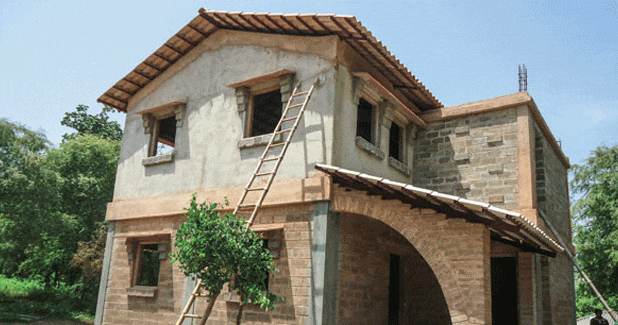Limestone Calcined Clay Cement (LC3) reduces cement production cost and capital investment to increase production capacity.
With various infrastructure projects and government initiatives being announced, the cement sector is set to witness unprecedented demand. But the high CO2 emissions of the cement making process need to be reduced to make it environment-friendly. Limestone Calcined Clay Cement (LC3) is low on clinker and has been developed under collaboration between the University of Las Villas, Cuba and Ecole Polytechnique FTdTrale de Lausanne, Switzerland, and funded by the Swiss government. In India, researchers from IIT-Delhi, IIT-Bombay and IIT-Madras have been contributing to the project through a feasibility study to study the behaviour of such cement in Indian conditions. The proposed LC3 is expected to reduce these emissions substantially and bring down the cost of cement production.
Shashank Bishnoi, Assistant Professor, Department of Civil Engineering, IIT-Delhi, shares how this material can benefit cement manufacturers.
Cuban experience
The cement was first used in Cuba. The authorities were looking at replacing the use of OPC by 25-30 per cent with calcined clay. While the project was successful, they realised that they could achieve higher replacement of clinker by adding crushed limestone to bring clinker content down by 45 per cent to 50 per cent. Crushed limestone was not of the highest quality and they did not have to heat it at 1,400 to 1,450¦C, as was the case with clinker. They could grind it while grinding the cement. Offering reduced CO2 emissions, the cement generated interest. But Cuba was too small a market to make an impact in global CO2 emissions. Hence, the Swiss Government wanted to tap the Indian market.
Indian experience
As part of the research, we have build a two-storey house in Jhansi using LC3, with reinforced concrete, precast element, hollow concrete blocks, roofing tiles, on site-constructed concrete in beams, slabs, columns and foundations. There are about 22 states in India that have metakaolin mines, and according to the Indian Bureau of Mines, there is 1 billion kaolinitic clay in India. And we are talking of lower grade clay from these mines. According to people from the industry we have interacted with, there could be five times as much of mineable materials available in those mines.
Reducing clinker
Commonly used Ordinary Portland Cement (OPC) contains 95 per cent clinker and 5 per cent gypsum, whereas Portland Pozzolana Cement (PPC) contains 60 to 75 per cent clinker and 5 per cent gypsum, the rest being fly-ash. Clinker is energy-intensive and a relatively expensive component of cement; through research, we are trying to reduce its usage to 40-50 per cent in LC3, which will inevitably reduce costs. To date, we have already done successful trials at 50 per cent in India. Abroad, there have been trials at 40 per cent, which have shown acceptable performance of the cement.
Discarded material
Apart from clinker, LC3 also consists of crushed limestone of a relatively low grade, calcined clay and about 5 per cent of gypsum. The limestone used in clinker commonly has to be of a certain quality and devoid of impurities. Keeping this is mind, we have used lower grade limestone, which is widely available in limestone mines and discarded for its impurities. Even the clay used in LC3 is of a relatively low grade and is hence dumped. This clay can be calcined at 600-700¦C - nearly half the temperature required for calcine clinker, which is 1,400-1,450¦C.
For places where clinker cannot be produced owing to unavailability of limestone, we are trying to use local materials. But its production will not be at a local scale as the product quality might deteriorate. We are also looking at an option where clinker can be purchased from cement plants and then transported to sites where it can be mixed with crushed limestone and calcined clay, which will also provide local jobs.
Cost-effectiveness
LC3 cement not only produces cement at a lower cost by reducing energy usage but decreases capital investment required to increase production capacity. The quality of cement or concrete produced will not be necessarily compromised in LC3. In fact, in certain cases, the product has better quality than PC and PPC. The use of clinker is lower than conventional cement, reducing material costs.
Work in progress
Cement is a controlled product and we cannot just start producing and selling a new type of cement in the country. We have not added anything new to the process of cement making, but are determining whether this cement will be suitable for all projects. The technical plan of whether this works or not is well laid out already. The biggest bottleneck of the material is the development of a standard and that may take 20 years.
We cannot afford this much time in a developing country like India. If the rate of housing growth increases further, it will add tremendous pressure on the Indian cement industry. More than 60 per cent of cement consumed is used in the housing industry. We can´t afford such high emissions. We have to ensure that cement is economically available at construction sites. We are trying to develop partnerships with people who are regularly involved in the standardization process and develop a certain standard for the production of LC3. Once the cement components are standardized, the technology can be used by cement making companies. The cement produced will have the same usage and concrete making process as its conventional counterparts.
LC3 Advantage!
- LC3 cement not only produces cement at a lower cost by reducing energy usage but decreases the capital investment required to increase production capacity.
- The use of clinker - the energy-intensive and relatively expensive component of cement - is lower than conventional cement, reducing material costs.
- LC3 makes use of discarded, low-grade clay and limestone, thus reducing costs. It also reduces increasing burden on depleting cement quantities.





















